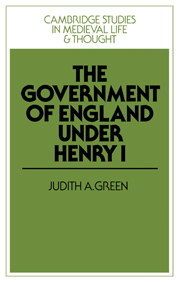Book contents
- Frontmatter
- Contents
- Preface
- Abbreviations
- 1 HENRY, KING OF THE ENGLISH
- 2 THE ROYAL ENTOURAGE
- 3 BISHOP ROGER AND THE EXCHEQUER
- 4 FINANCE
- 5 THE LION OF JUSTICE
- 6 LOCAL GOVERNMENT
- 7 THE KING'S SERVANTS
- 8 THE SHERIFFS
- CONCLUSION
- Tables I-III: the 1130 pipe roll
- Biographical appendix
- Tables IV-VI: the 1130 group
- Select bibliography
- Index
6 - LOCAL GOVERNMENT
Published online by Cambridge University Press: 03 February 2010
- Frontmatter
- Contents
- Preface
- Abbreviations
- 1 HENRY, KING OF THE ENGLISH
- 2 THE ROYAL ENTOURAGE
- 3 BISHOP ROGER AND THE EXCHEQUER
- 4 FINANCE
- 5 THE LION OF JUSTICE
- 6 LOCAL GOVERNMENT
- 7 THE KING'S SERVANTS
- 8 THE SHERIFFS
- CONCLUSION
- Tables I-III: the 1130 pipe roll
- Biographical appendix
- Tables IV-VI: the 1130 group
- Select bibliography
- Index
Summary
In the eleventh century, the English monarchy had been unusual in western Europe for its well-developed local government. Most of England at the time of the Norman Conquest had been divided into hundreds (in the south) and wapentakes (in the north). These were grouped into shires under the authority of sheriffs, and shires were in turn grouped into regional governorships under the authority of earls. The Conquest had altered this structure in several ways: hundreds, wapentakes, and shires were retained, but the earldoms were swept away in their old form, the title earl with different powers being preserved for a few favoured individuals. Into the basic structure were inserted two more specialized kinds of government agents, those who held the newly built castles for the king, and the officials appointed to look after newly created hunting reserves. In looking at each of these elements, significant trends in several areas in Henry Ts reign can be identified, all bearing witness to a general strengthening of royal authority at the local level. The reign moreover saw a marked extension of royal authority in a geographical sense, into the northern counties of England, as part of the opening up of that region to Norman settlement much more decisively than before.
William the Conqueror granted the title of earl to very few men; in most cases their authority was limited to a single county where they enjoyed a wide range of powers.
- Type
- Chapter
- Information
- The Government of England under Henry I , pp. 118 - 133Publisher: Cambridge University PressPrint publication year: 1986



